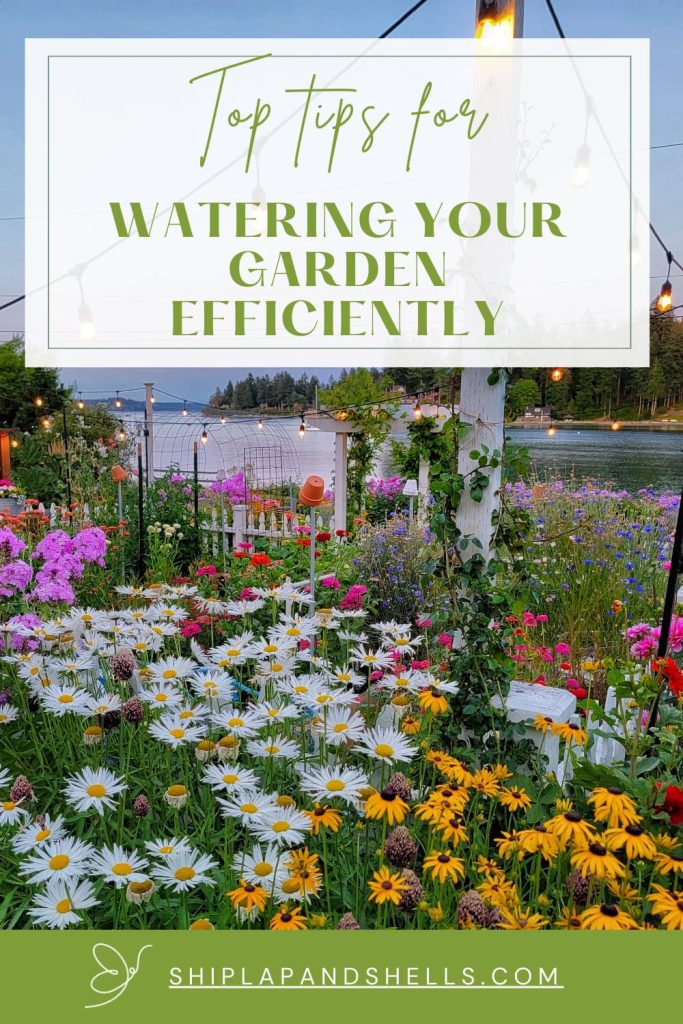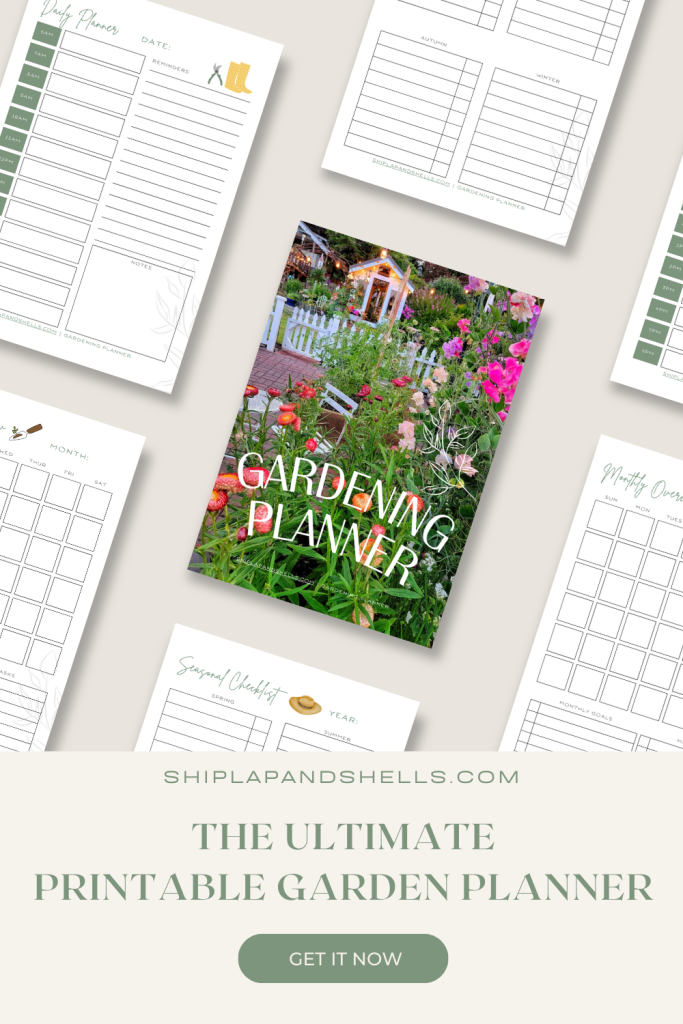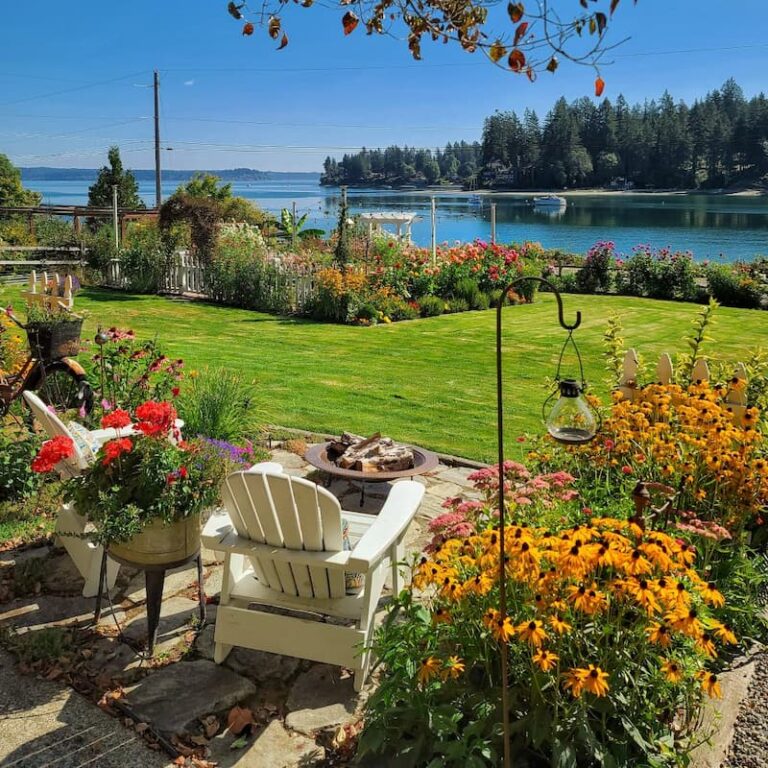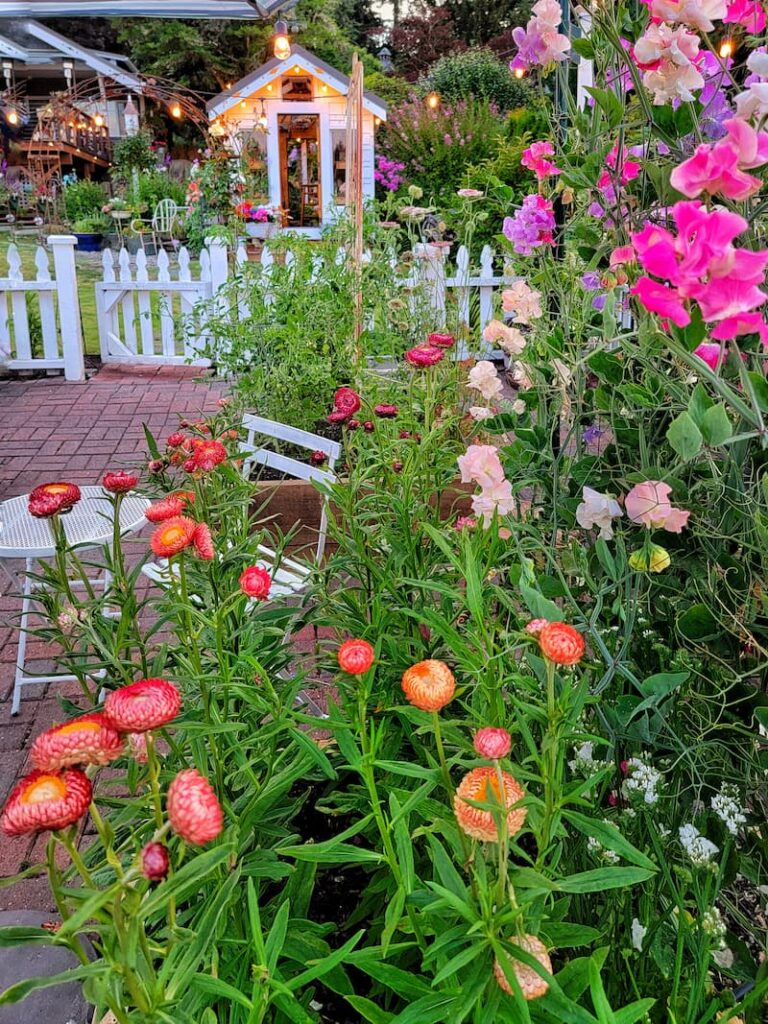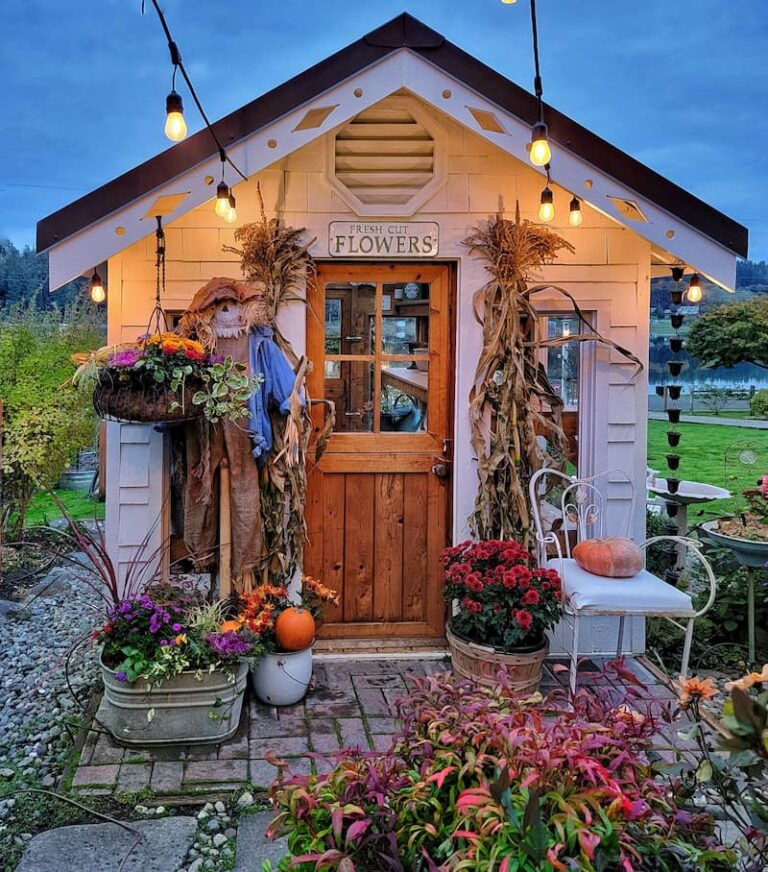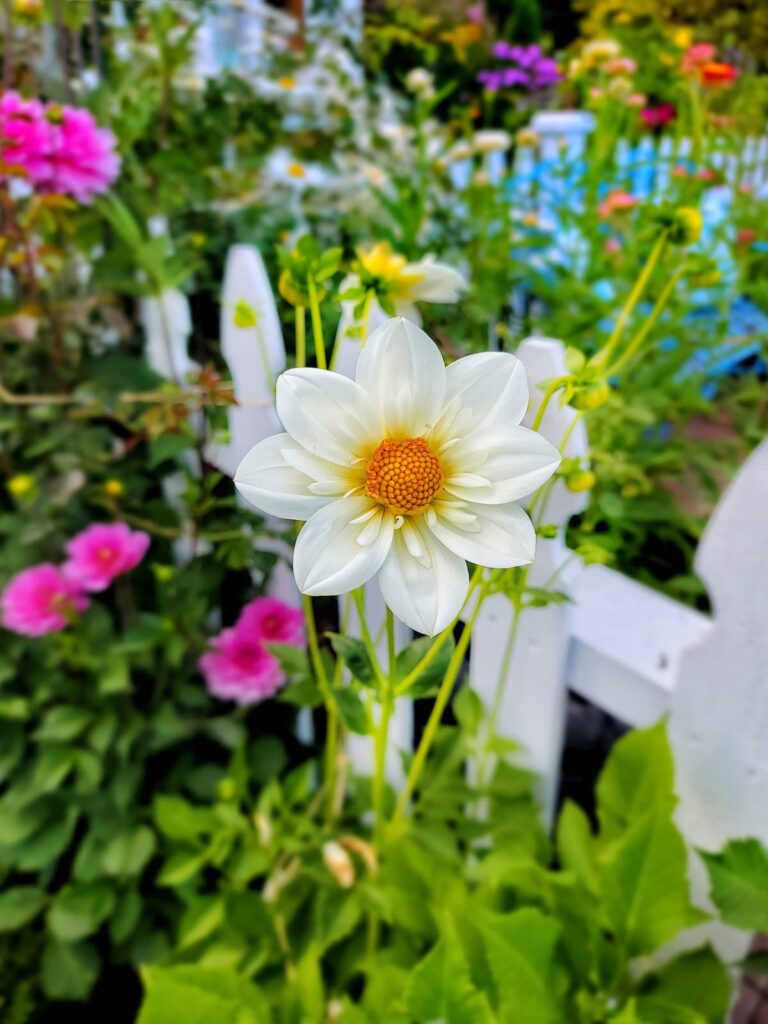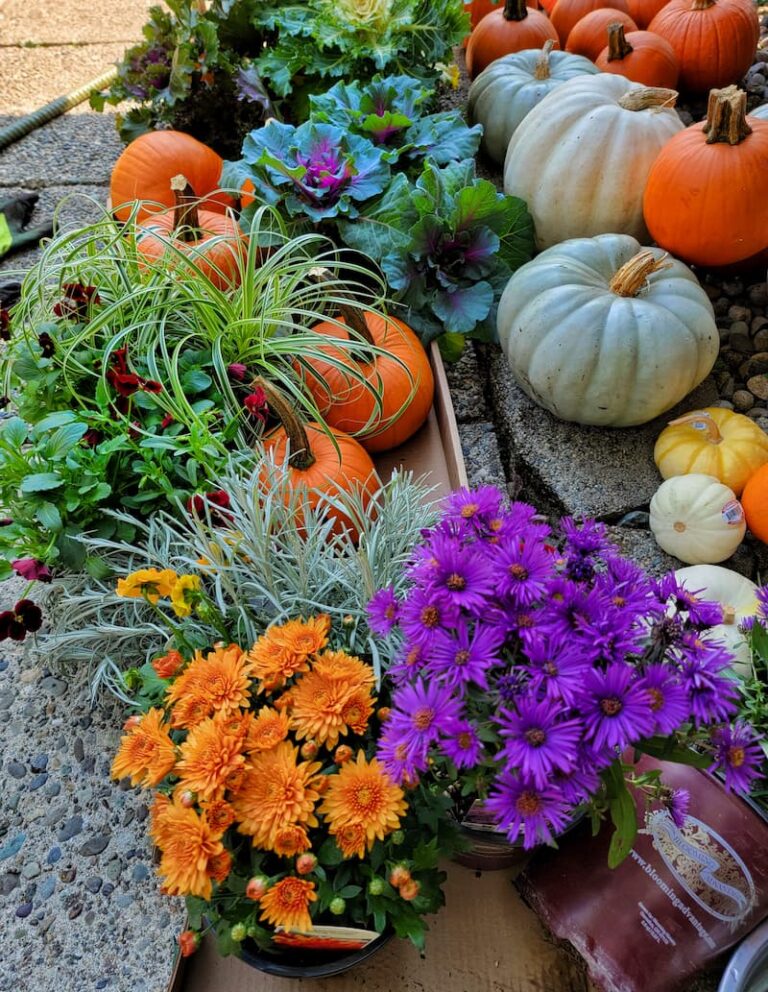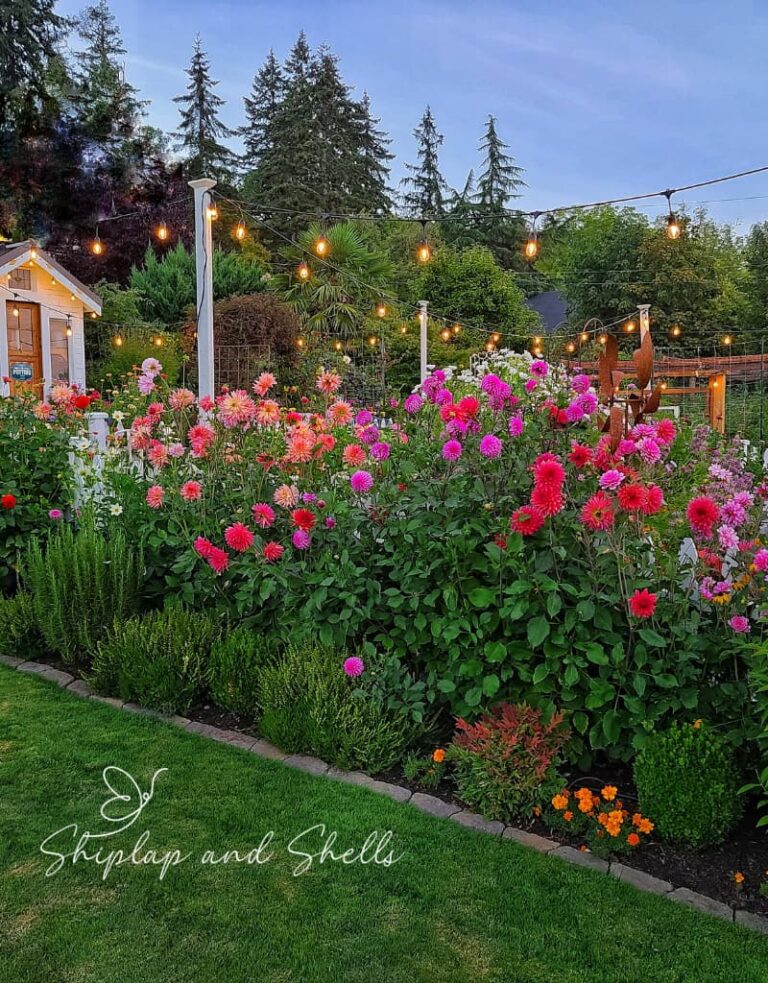Transform Your Flower Garden with Top Tips for Watering Efficiently
Watering your garden efficiently can dramatically improve plant growth, water conservation, and time and effort savings. This guide provides easy and effective tips for efficient plant watering to help your garden plants thrive throughout the growing season.
Watering your garden seems pretty straightforward, doesn’t it? But when I first started my flower garden, I had no idea what I was doing. I just thought that if you turned on the sprinklers and the plants looked wet, we were good! That wasn’t the case, especially in the dry summer heat.
Don’t make the same mistakes I did! Let’s look at proper watering techniques and best practices to make your garden vibrant and healthy this growing season. Grab your watering can, and let’s go!
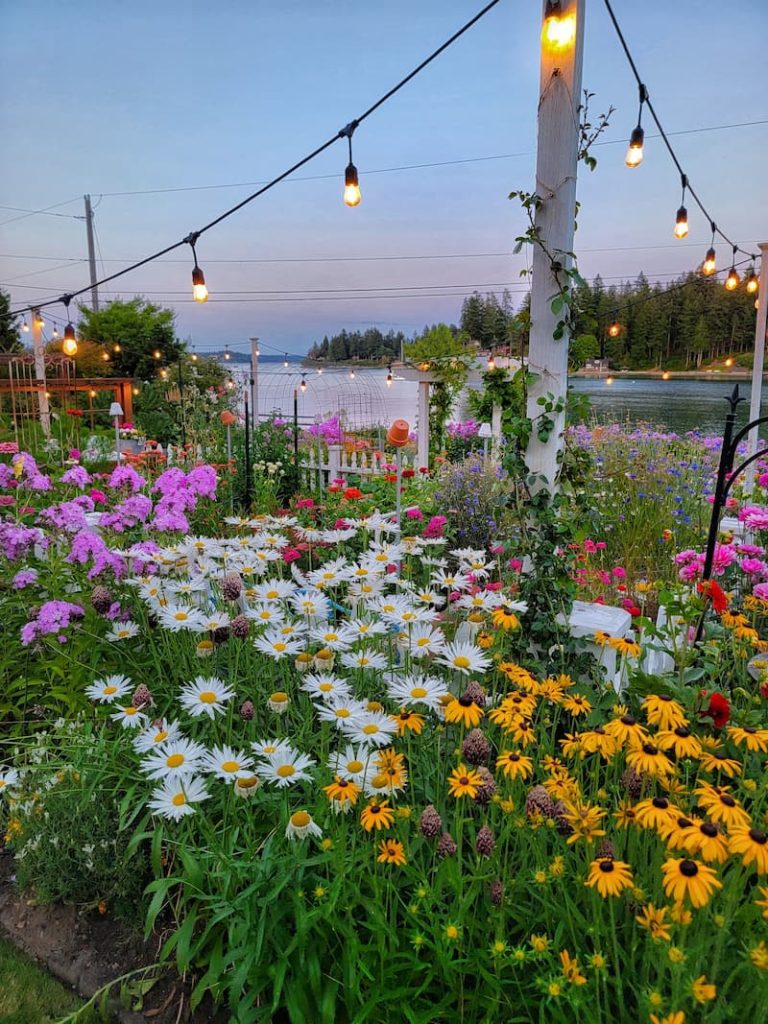
As an Amazon affiliate, I earn from qualifying purchases at no extra cost to you. My blog contains other affiliate links for your convenience as well. Click here to read my privacy policy.

What Is Water-Efficient Gardening?
Water-efficient gardening is about using water wisely to maintain a healthy and flourishing garden without waste. It’s important to provide your plants with the right amount of water at the right time, giving them what they need to thrive while minimizing water loss.
Techniques like deep watering encourage roots to grow deeper and become more drought-resistant. Mulch helps retain soil moisture and reduce evaporation.
Additionally, choosing drought-tolerant plants, utilizing drip irrigation systems, and watering during the early morning or early evening can significantly enhance water efficiency.
These water-efficient practices will create a strong, sustainable garden that can withstand dry spells and changing climate conditions. And conserving water is the cherry on top!
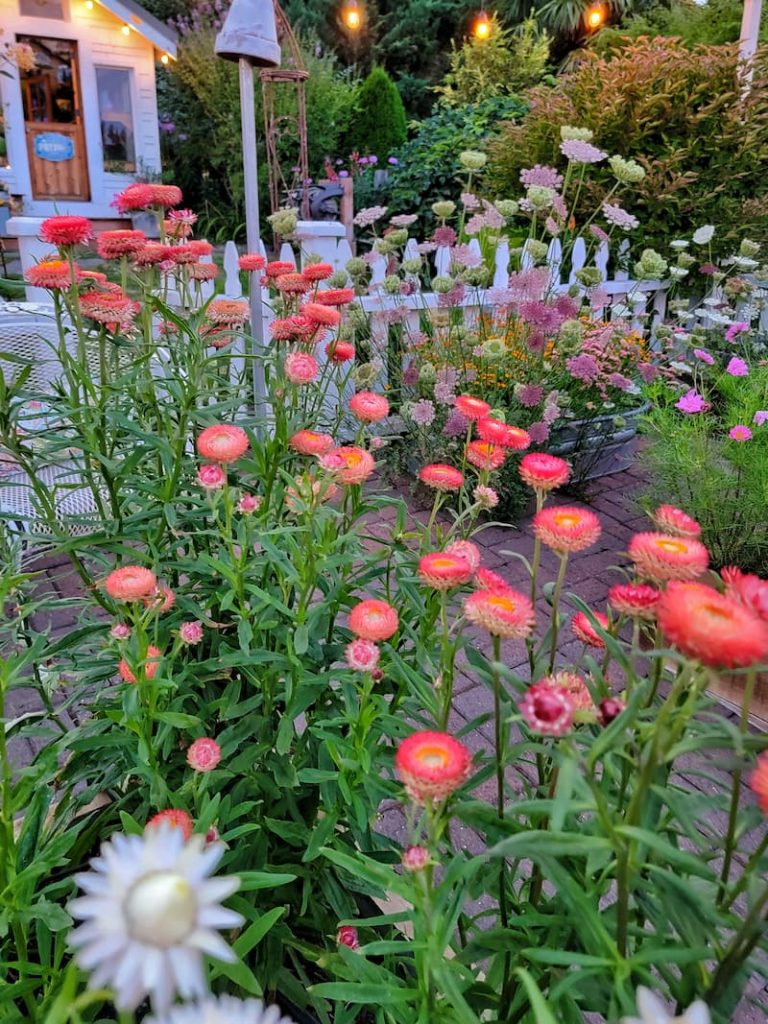
How Much Water Does My Garden Need?
Determining the right amount of water for your garden needs can be a balancing act. It depends on factors such as plant type, soil composition, weather conditions, and the time of year.
As a guideline, most gardens require about 1 to 2 inches of water per week, either from rainfall or supplemental watering. Sandy soil drains quickly and may need more frequent watering, while clay soil retains moisture longer and requires less frequent watering.
The types of plants you grow also play a significant part. Vegetables and annuals often need more water than established perennials and native plants that adapt to local conditions.
You might need more water during hotter and windier weather because of the increasing evaporation rates during these conditions.
It is important to monitor soil moisture levels and adjust your watering practices. Watch for both overwatering and underwatering to maintain a healthy, thriving garden.
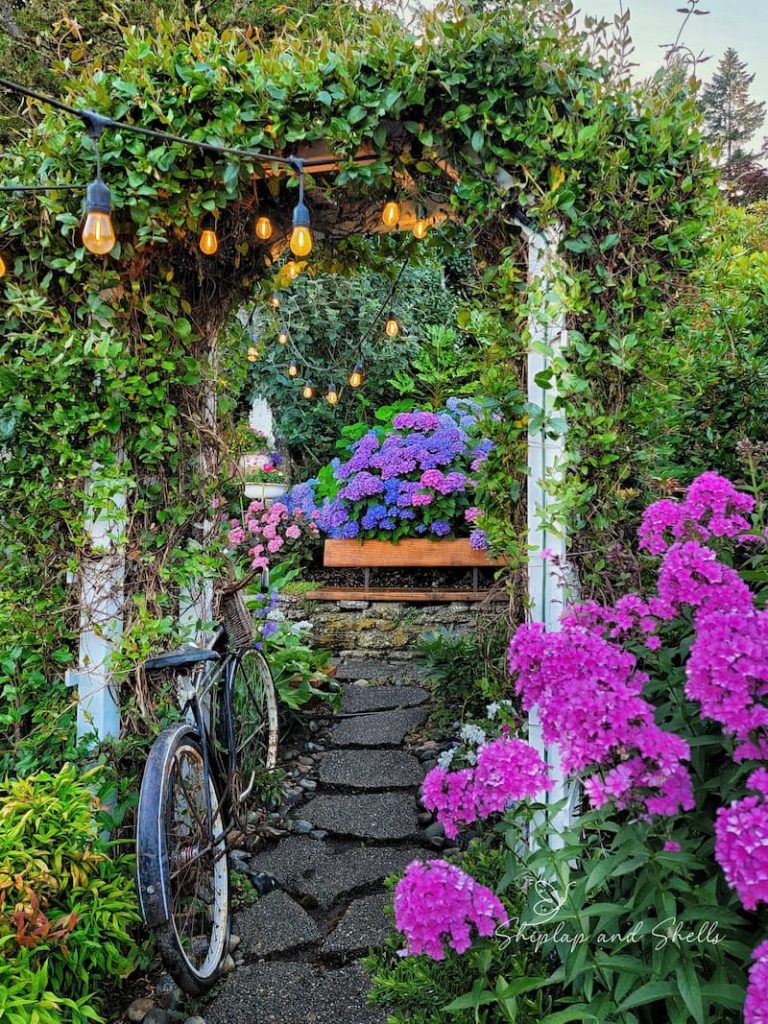
Moisture Needs of Specific Plants
Understanding the moisture needs of individual plants is key to efficient garden watering.
Vegetables typically require more water to produce fruitful and healthy crops, especially during their growth and fruiting stages. Leafy greens and root vegetables need consistent moisture, while fruiting vegetables like tomatoes and peppers may need more frequent watering.
Many flowers have varied water requirements based on their species. Annual flowers generally need regular watering to keep their blooms vibrant, while established perennials might be more drought-tolerant once their roots are well-developed.
Drought-resistant plants, such as succulents and certain ornamental grasses, are designed to thrive with minimal water and can endure dry conditions, making them ideal for low-maintenance gardening.
Plants like hydrangeas and ferns require consistently moist soil to flourish.

Moisture Needs of Different Soil Types
Different soils have various moisture retention and drainage properties. Knowing the type of soil in your garden will help you choose the right watering practices so your plants receive the right amount of water without overwatering or underwatering.
Here’s a closer look at the main soil types, their water needs, and tips on determining your soil type.
Sandy Soil
This soil drains quickly and does not retain water well because of its large particles. Gardens with sandy soil typically need more frequent watering to keep plants hydrated.
To identify sandy soil, take a handful of moist soil and rub it between your fingers. Sandy soil will feel gritty and fall apart easily.
Add organic matter like compost or mulch to improve moisture retention, which helps retain water and nutrients.
Clay Soil
Plants in clay soil need less frequent watering, but when you do water, ensure it’s deep enough to penetrate the dense soil. Clay soil has small, tightly packed particles that hold onto water, often leading to slow drainage and potential waterlogging.
To identify clay soil, squeeze a moist handful into a ball. You have clay soil if it forms a sticky, firm ball that doesn’t easily crumble.
Amending clay soil with organic matter can improve drainage and aeration, improving plant growth.
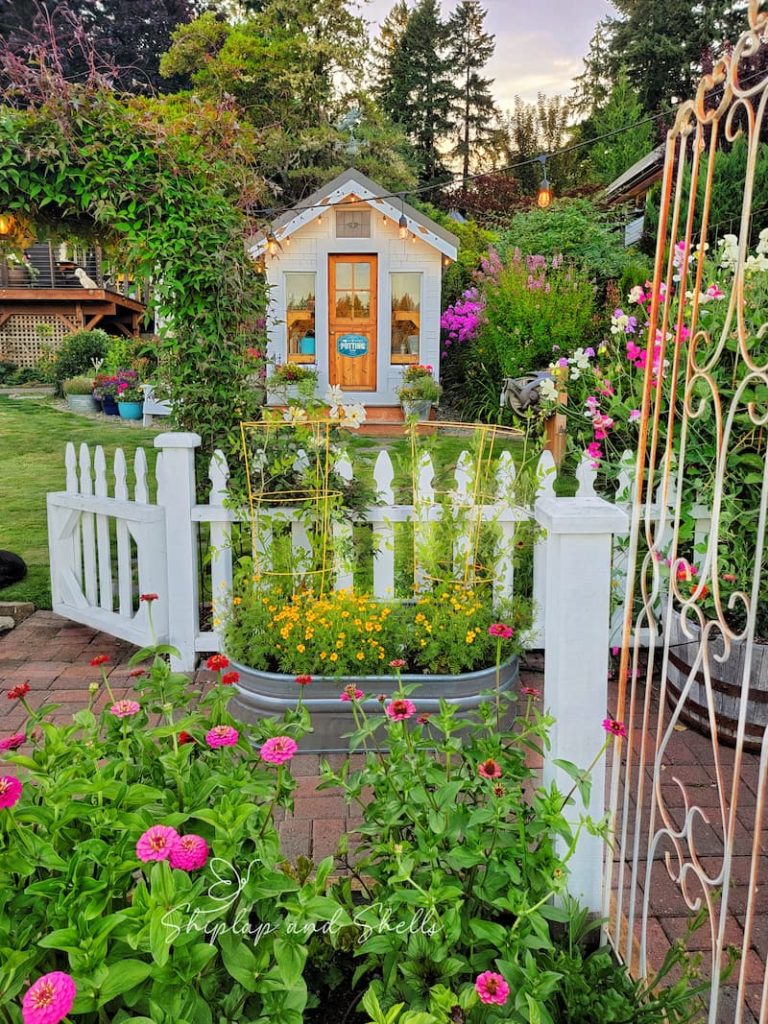
Loamy Soil
This soil provides ideal conditions for most plants because of its balanced sand, silt, and clay mixture. It retains moisture well while still draining sufficiently.
Loamy soil feels crumbly and lightly gritty yet smooth and holds together loosely when squeezed.
Gardens with loamy soil generally require moderate watering because this soil type maintains an even moisture level. Regularly adding compost can help maintain its balanced structure and fertility.
Silty Soil
Because of its fine particles, silty soil retains moisture better than sandy soil but drains more quickly than clay. It feels smooth and slightly soapy to the touch.
Even though it holds water well, silty soil can become compacted, reducing aeration and drainage over time.
Squeeze a moist handful. If the soil forms a ball but breaks apart easily, your garden has silty soil. Organic matter can help improve structure and prevent compaction, ensuring better water infiltration and root growth.
How to Determine Your Soil Type
Moisten a small amount of soil and rub it between your fingers to assess its texture.
You can also conduct a jar test: place a soil sample in a jar with water, shake it well, and let it settle. The soil will separate into layers, with sand at the bottom, silt in the middle, and clay on top.
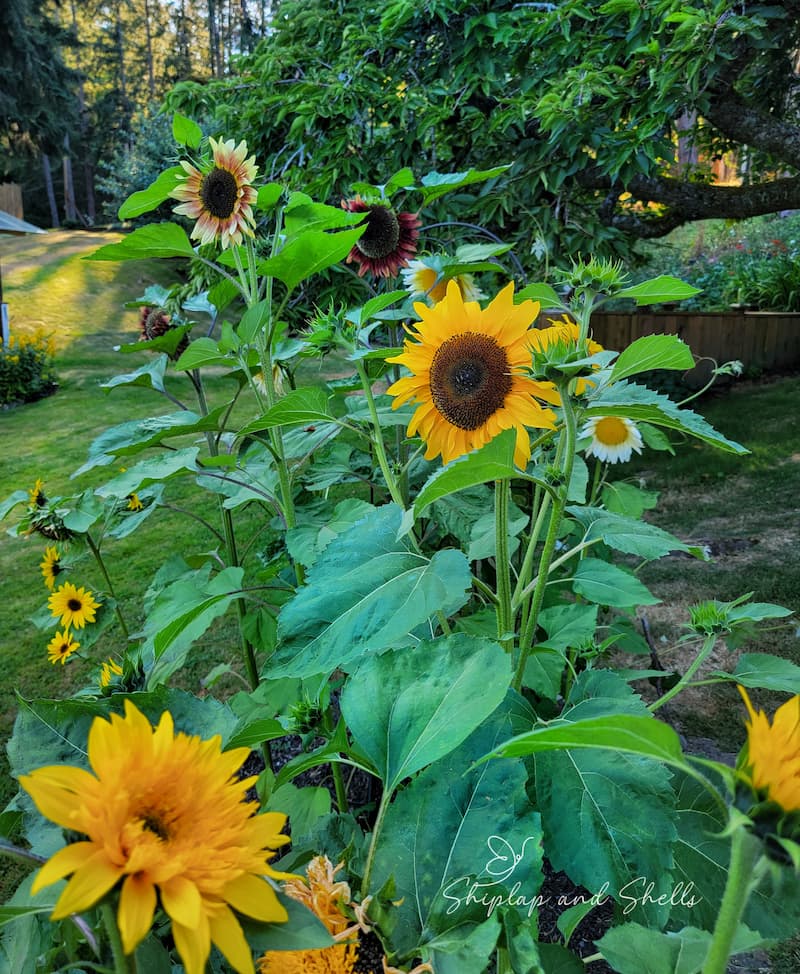
Check the Weather Forecast
Observing the weather forecast is a simple and effective way to ensure your garden’s water efficiency.
Rain is nature’s free irrigation system, and taking advantage of it can save water and effort. Before reaching for the hose or turning on your irrigation system, check the forecast to see if rain is coming. If your area expects significant rainfall, you can skip watering and let the rain do the job.
This prevents overwatering, which can harm plants and lead to waterlogged soil, and conserves water during dry spells. By aligning your watering schedule with the weather, you optimize your garden’s hydration, support healthy plant growth, and contribute to sustainable gardening practices.
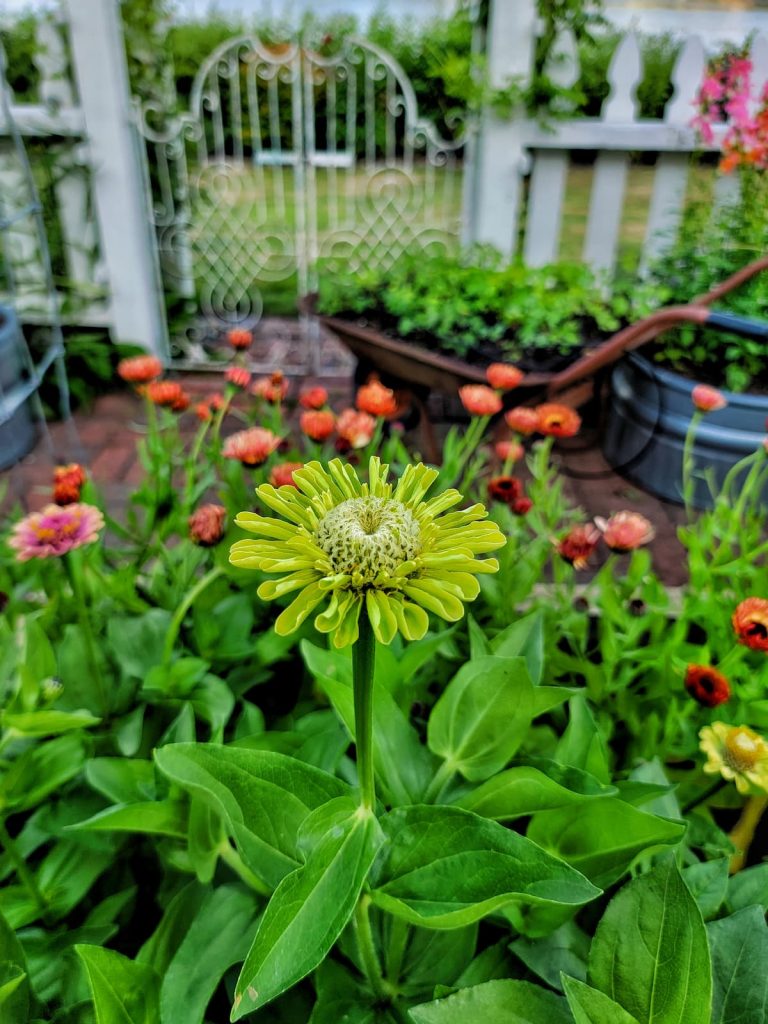
Different Ways to Efficiently Water Your Garden
Hydrating your garden efficiently involves choosing the right watering system to deliver water directly to your plants while minimizing waste. There are several ways to accomplish this, each with benefits and considerations.
This section will share three popular water source methods: hand watering, drip irrigation or soaker hoses, and traditional sprinklers or hose-end sprinklers.
Hand Watering
Hand watering is a traditional and straightforward method. Using a watering can or garden hose with a spray nozzle, you can target specific plants and areas that need the most moisture, ensuring that water goes exactly where it’s needed.
This method is especially efficient for small gardens, container plants, and new plants that require gentle and careful watering. Its ability to prevent water wastage and provide individual care to plants makes it a favorite for gardeners with focus and time.
However, hand watering can be time-consuming for larger gardens and may not be the best option for saving time and effort.
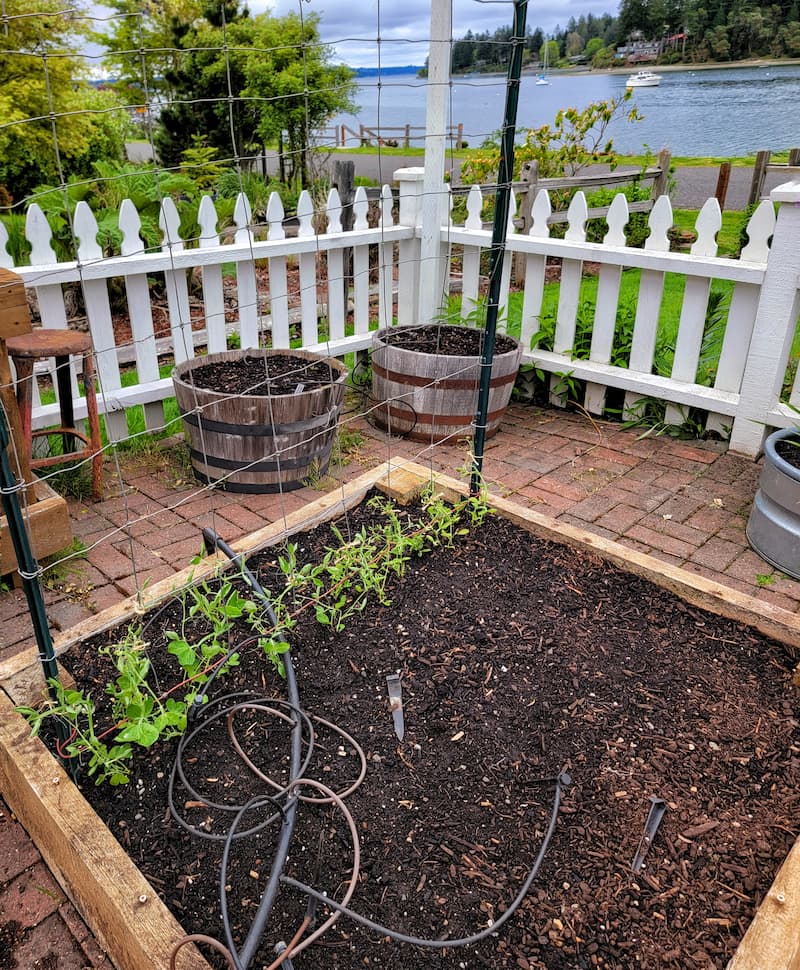
Drip Irrigation or Soaker Hoses
Drip irrigation systems and soaker hoses are highly efficient watering methods that deliver water directly to plants’ root zones, minimizing evaporation and runoff.
These watering systems use a network of tubes and emitters or porous hoses that release water slowly and evenly, ensuring deep soil penetration and reducing water waste.
This method is particularly effective for vegetable gardens, flower beds, and landscapes with varying plant types and spacing.
Drip systems and soaker hoses can be set on timers for consistent and automated watering schedules.
While the initial setup might require some investment and effort, the long-term benefits of water conservation and healthier plant growth make these systems a smart choice for water-efficient gardening.
Traditional Sprinkler/Hose-End Sprinkler
Traditional and hose-end sprinklers are convenient for covering lawns and large landscape areas and providing even water distribution over lawns and garden beds. However, they are generally less efficient than other methods due to water loss from evaporation, wind drift, and runoff.
Adjusting sprinkler system settings to avoid overwatering and ensure they water the garden without a lot of water on the sidewalks or driveways is essential to maximizing efficiency.
The best time of day to water your garden is in the early morning or early evening, which can also help reduce evaporation.
While traditional sprinklers are easy to use and effective for large areas, their efficiency can be improved with careful monitoring and adjusting to the specific needs of your garden.
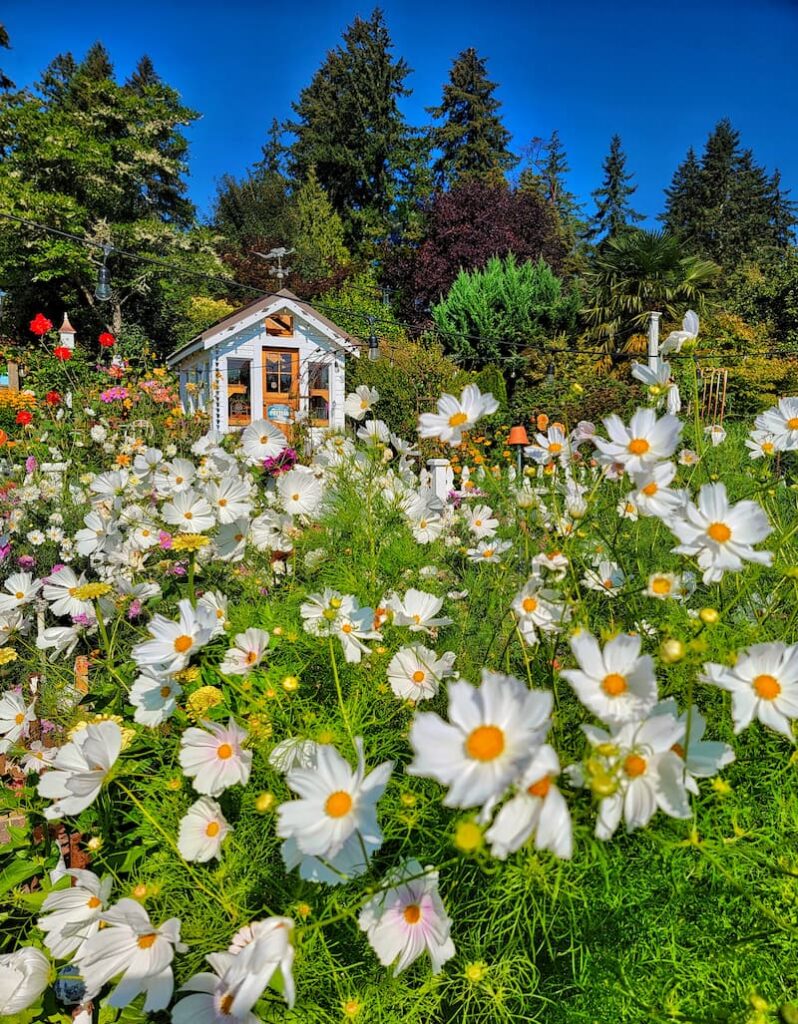
4 Tips for Watering Your Garden Efficiently
Creating a water-efficient garden goes beyond choosing the right watering method. Use smart watering practices that ensure your plants receive the optimal amount of moisture without wasting water.
In this section, we’ll share essential tips for watering your garden efficiently. From checking moisture levels and targeting the roots to watering deeply and recognizing signs of overwatering, these strategies will help you maintain a healthy, thriving garden with enough water for your plants.
Check Moisture Levels
Before you water, it’s important to check the moisture levels in your soil. Overwatering can be as harmful as underwatering, leading to root rot and other issues.
Use a soil moisture meter or simply stick your finger about an inch into the soil to see if it’s still damp. If it is, you can wait a bit longer before watering. This practice helps you avoid unnecessary watering and ensures your plants get the right amount of moisture they need.
Target the Roots
When watering, less water is delivered to the leaves and directly to the root zone, where plants absorb nutrients and moisture. Avoid wetting the foliage, leading to fungal diseases and inefficient water use.
Watering cans with long spouts, soaker hoses, or drip irrigation systems can help you accomplish this. Focusing on the plant roots ensures that water reaches the part of the plant that needs it most, promoting stronger and healthier growth.
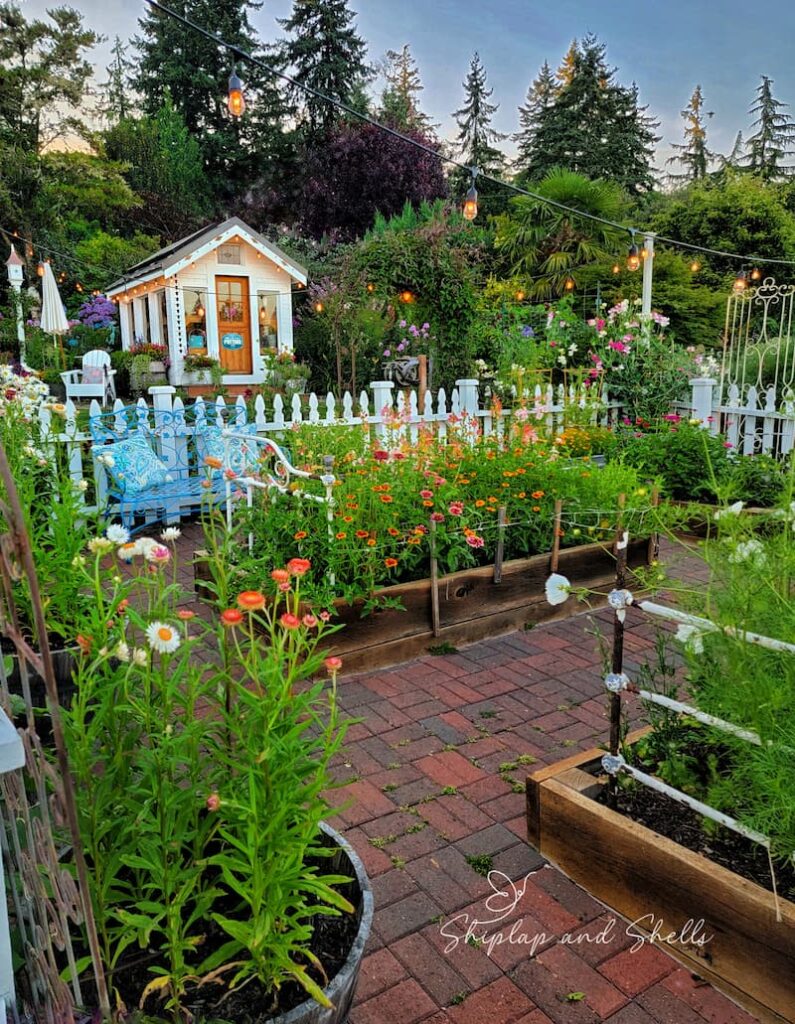
Water Deeply, Less Frequently
One key to efficient watering in your garden is to water deeply but less frequently. This encourages plants to develop deep root systems, making them more drought-resistant and resilient.
Instead of giving your garden a daily light sprinkle, water thoroughly until the soil is moist several inches down, then allow the top few inches to dry out before watering again. This method not only conserves water but also promotes strong plant development.
Look for Signs of Overwatering
Overwatering can harm your garden, leading to issues like root rot, nutrient leaching, and the proliferation of pests and diseases.
It’s crucial to recognize the signs of overwatering, such as yellowing leaves, wilting despite wet soil, and the presence of mold or fungus.
You can adjust your watering habits by monitoring your plants for these symptoms. Reducing the frequency and ensuring proper drainage can help prevent the negative effects of overwatering, keeping your garden healthy and vibrant.
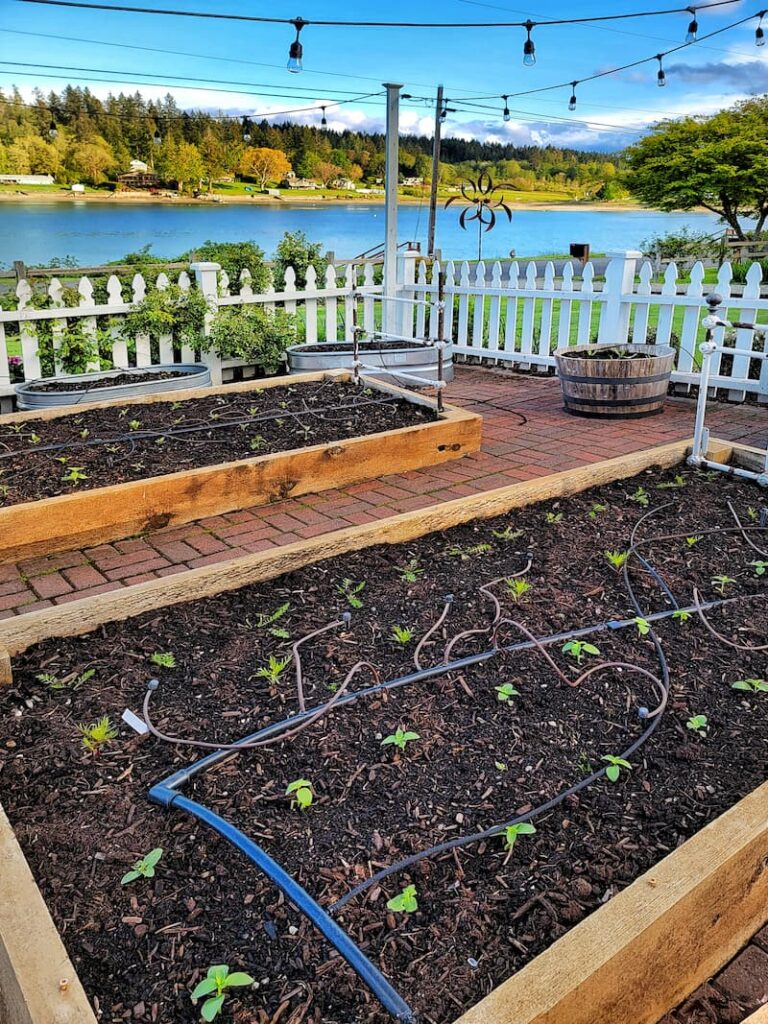
Best Way to Water Raised Beds & Containers Efficiently
Watering raised beds and container plants efficiently requires a slightly different approach than traditional in-ground gardens.
Raised beds and containers tend to dry out more quickly due to their improved drainage and increased exposure to air. However, with the right techniques, you can ensure your plants receive the optimal amount of moisture while conserving water.
Watering Raised Beds
Raised beds benefit from their well-draining soil, which prevents waterlogging and promotes healthy root growth. However, this also means they need more frequent watering, especially during hot, dry weather.
Consider using soaker hoses or a drip line to water a raised bed efficiently. These devices deliver water directly to the soil and reduce evaporation.
Mulching the soil surface with organic materials like straw or wood chips can also help retain moisture, keeping the soil cooler and reducing the need for frequent watering.
Check the moisture levels regularly and adjust your watering schedule based on the weather and your plants’ specific needs.
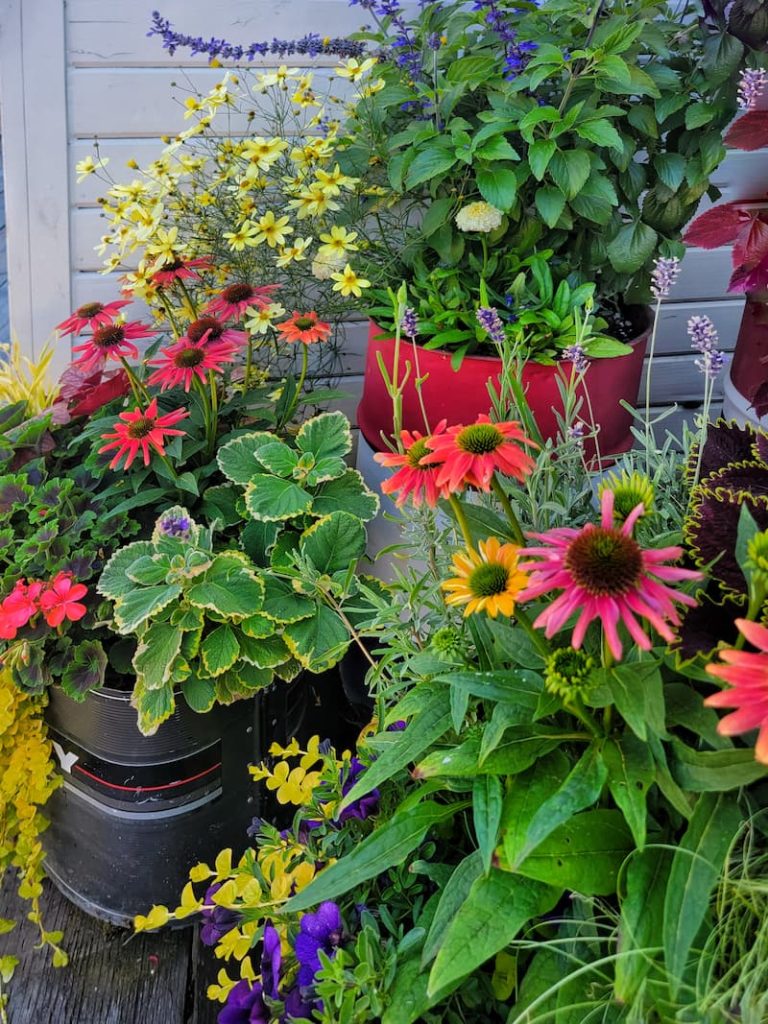
Watering Container Plants
Due to their limited soil volume, container plants can dry out faster than raised beds.
To efficiently water container plants, choosing pots with adequate drainage holes is essential to prevent water from pooling at the bottom. Water your garden containers thoroughly until water runs out of the drainage holes, ensuring the entire root ball is moistened.
Self-watering containers can be a great investment, providing a consistent water supply and reducing manual watering frequency. Grouping containers together can create a microclimate that helps retain moisture, and using a high-quality potting mix can further improve water efficiency.
Placing containers in locations that receive morning sun and afternoon shade can help reduce water loss due to evaporation.
Garden Supplies and Tools
Check out my favorite garden supplies and tools for the growing season. Whether you’re looking for potting soil or deer repellent, you’ll find what I use in my own garden.
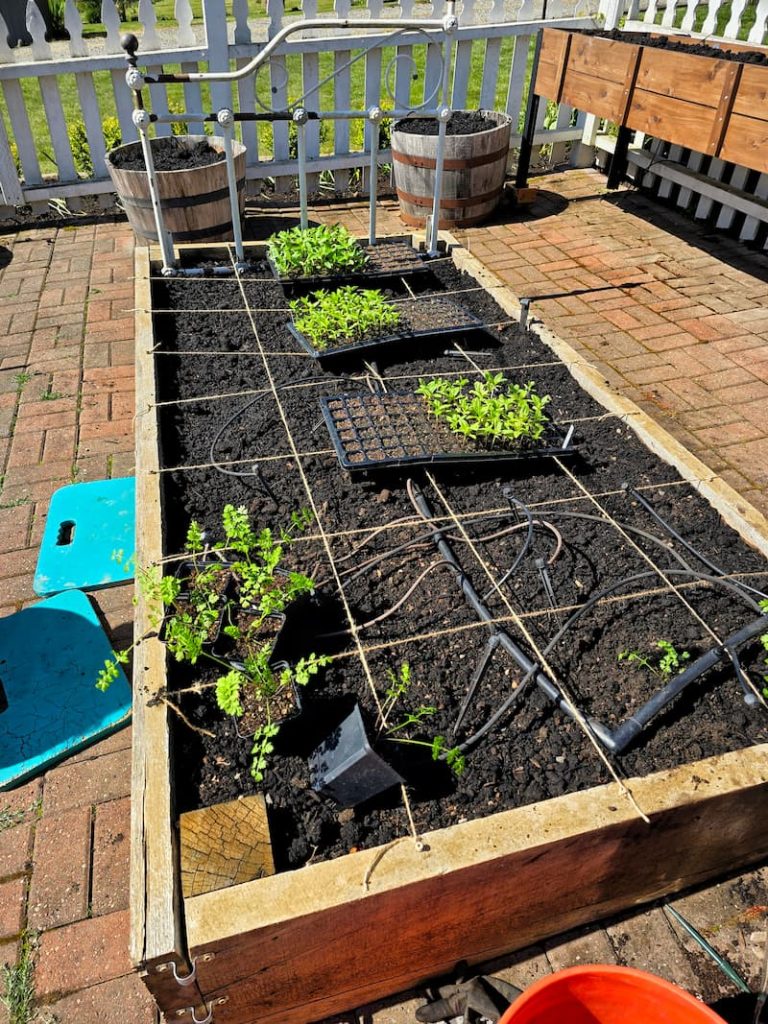
Invest in Water-Saving Equipment to Efficiently Water a Garden
Investing in water-saving equipment is a good way to maximize water efficiency in your garden. These tools help conserve water and ensure your plants receive consistent and adequate moisture, leading to healthier growth and reduced water waste.
Here are some highlights of the best water-saving resources available, including soaker hoses, drip irrigation systems, watering timers, and moisture meters. Each of these tools can make a significant difference in how effectively you water your garden.
Soaker Hose
A soaker hose is an excellent investment for any garden. This porous hose slowly releases water directly into the soil, ensuring deep and even watering.
By delivering water right to the root zone, soaker hoses minimize evaporation and runoff, making them far more efficient than traditional overhead sprinklers.
Soaker hoses are great for garden beds, rows of vegetables, and around the base of shrubs and trees. Easy to set up and adjust, they provide a consistent and gentle water supply that promotes strong root development and healthy plants.
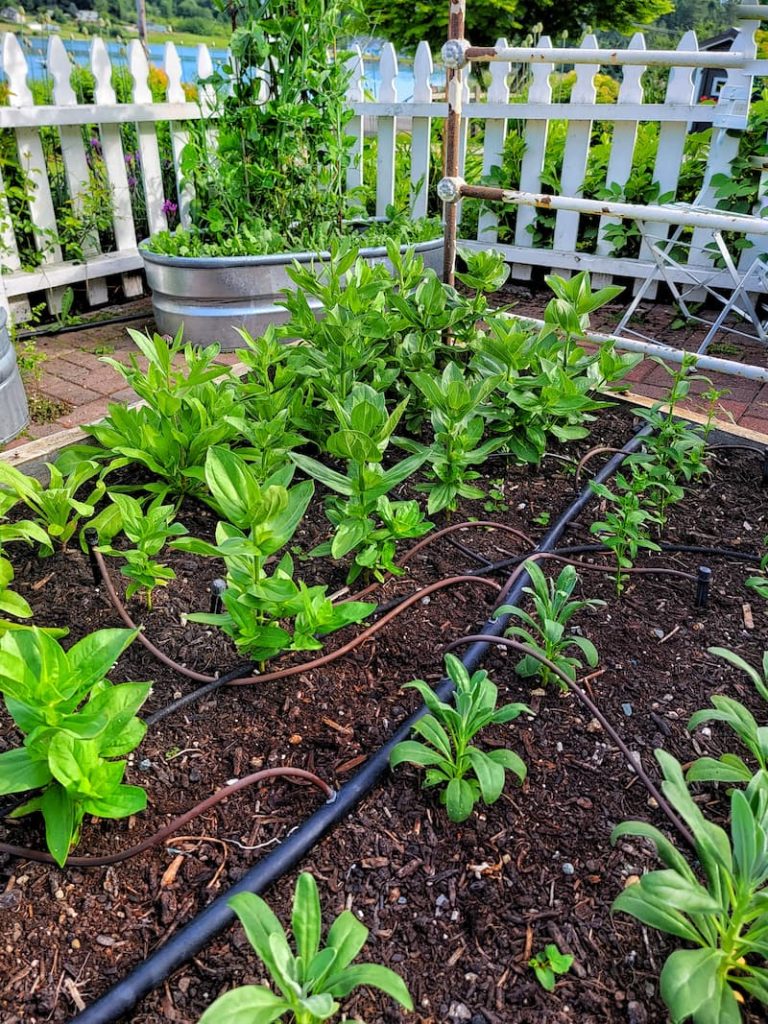
Drip Irrigation System
These systems are one of the most efficient ways to water a garden. They deliver water directly to the base of the plant and reduce evaporation.
Drip irrigation is highly customizable. You can adjust the flow rate and placement of emitters to meet the specific needs of different plants. This method is ideal for vegetable gardens, flower beds, and landscapes with varied plant types and spacing.
Although the initial setup can be more complex and costly, the long-term benefits of water conservation and improved plant health make drip irrigation a worthwhile investment.
Watering Timer
A watering timer is a handy tool that can significantly enhance your garden’s water efficiency.
A timer automates your watering schedule and ensures that your garden receives the right amount of water at the optimal times, such as early morning or evening when evaporation rates are lower. This prevents overwatering and underwatering, promotes consistent plant growth, and reduces water waste.
Timers can be easily attached to soaker hoses, drip irrigation systems, or traditional sprinklers, providing a convenient way to manage your garden’s watering needs without constant manual options.
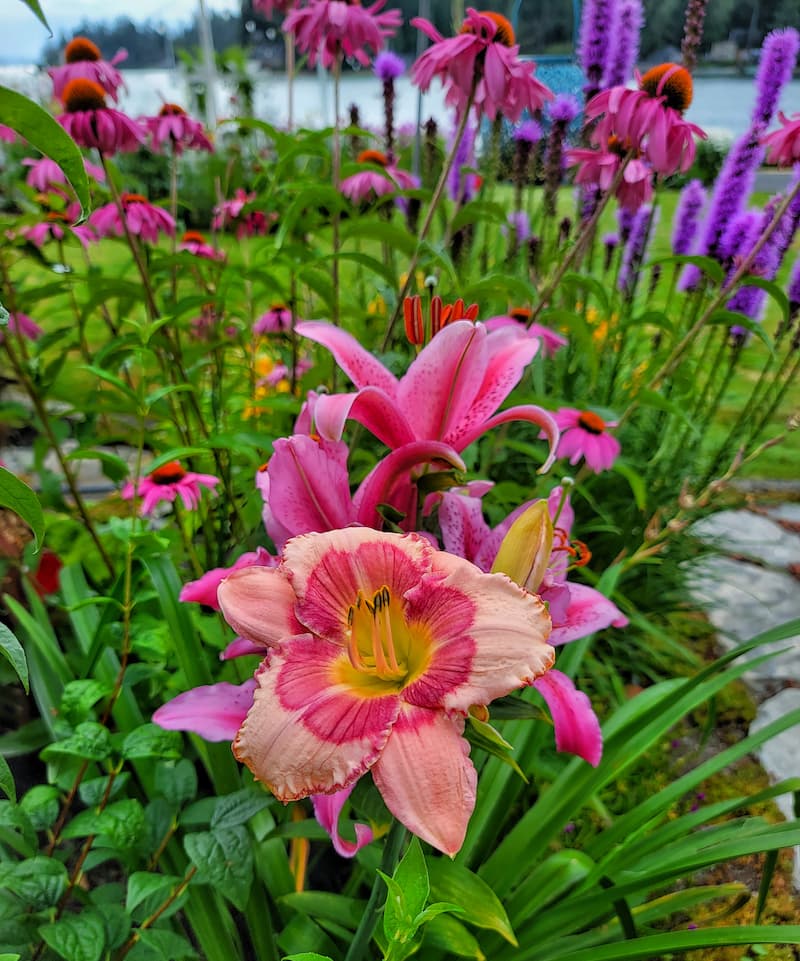
Moisture Meter
A moisture meter is a simple yet effective tool for monitoring soil moisture levels. By inserting the probe into the ground, you can get an accurate reading of how much water your plants can access at the root level.
Adjust your watering schedule based on actual soil conditions rather than guesswork.
Moisture meters are especially useful for gardeners with various types of plants, each with different water needs. Investing in a moisture meter lets you decide when and how much to water, ensuring optimal plant health and efficient water use.
Smart Irrigation Controllers
Smart irrigation controllers take automated watering to the next level. These devices connect to weather stations or use local weather data to adjust your watering schedule based on real-time conditions.
They can reduce or increase watering during rainy periods or dry spells, ensuring your garden gets the right amount of water without any manual adjustments. This technology helps save water and ensures your garden stays healthy year-round.
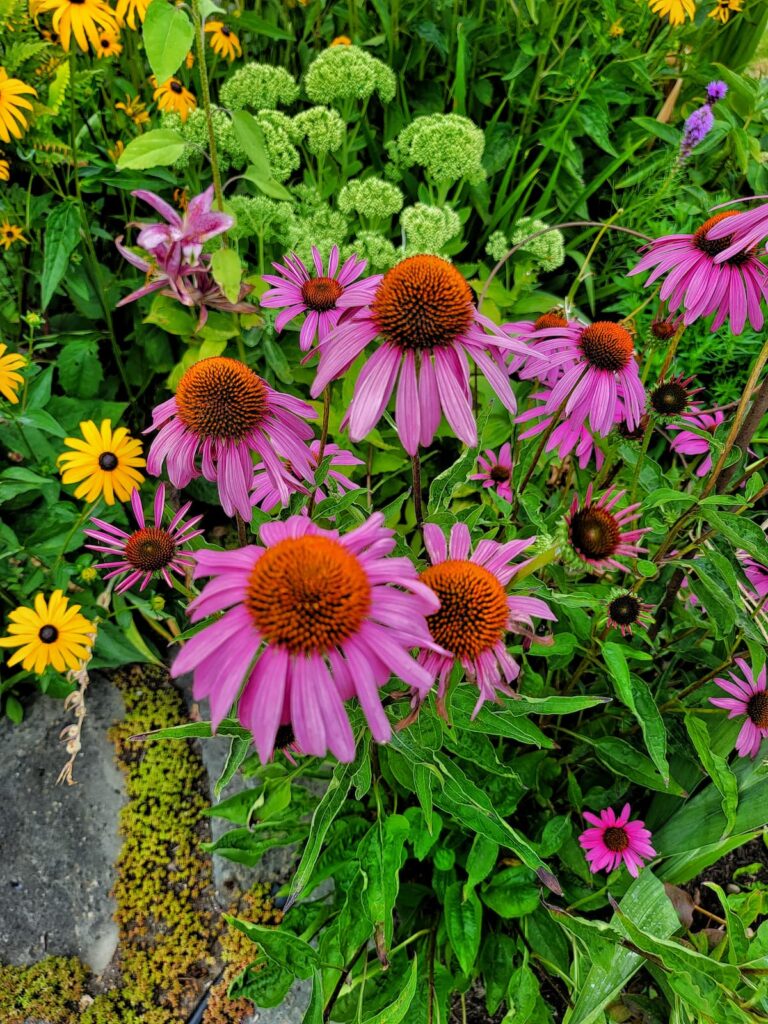
Hose Nozzles with Adjustable Settings
Using hose nozzles with adjustable settings allows you to control the water flow and pressure, making targeting specific areas and plants easier.
Gentle spray settings are ideal for delicate seedlings, while more powerful streams can be used for larger plants or cleaning garden tools. Adjustable nozzles help prevent overwatering and ensure water is delivered where needed most for overall efficiency.
Rain Gauges
A rain gauge is a simple tool measuring the rainfall your garden receives. By keeping track of natural precipitation, you can adjust your watering schedule accordingly and avoid unnecessary watering.
Plant Watering Spikes
Plant watering spikes are a convenient and efficient way to hydrate container plants. They’re often made from ceramic or plastic, inserted into the soil of a container, and attached to a water source like a bottle or reservoir.
They release water slowly and directly to the roots, ensuring consistent moisture levels without overwatering. This is especially useful for potted and young plants that dry out quickly.
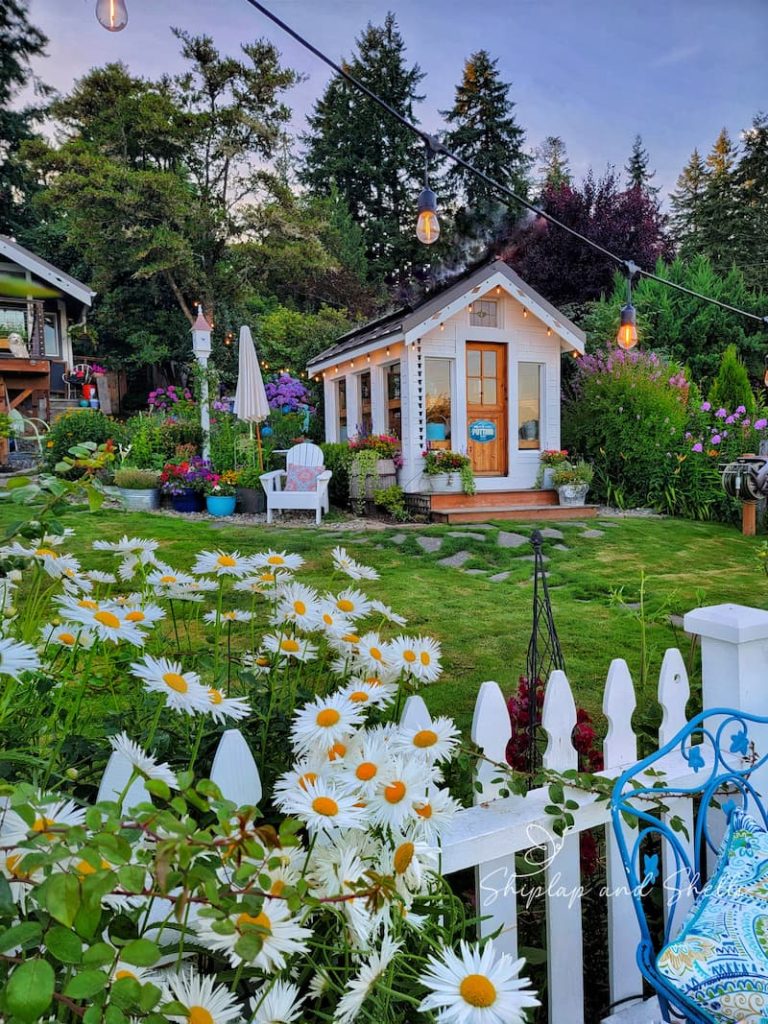
More Ways to Practice Water-Efficient Gardening
Rain Barrels for Collecting Water
Collecting rainwater with a rain barrel is a good practice for using natural precipitation for your garden.
Rain barrels, placed under downspouts, capture runoff from your roof and store it for later use. This conserves municipal water and provides plants with untreated, chemical-free water.
Using rainwater for irrigation can significantly reduce water bills and contribute to a more sustainable garden.
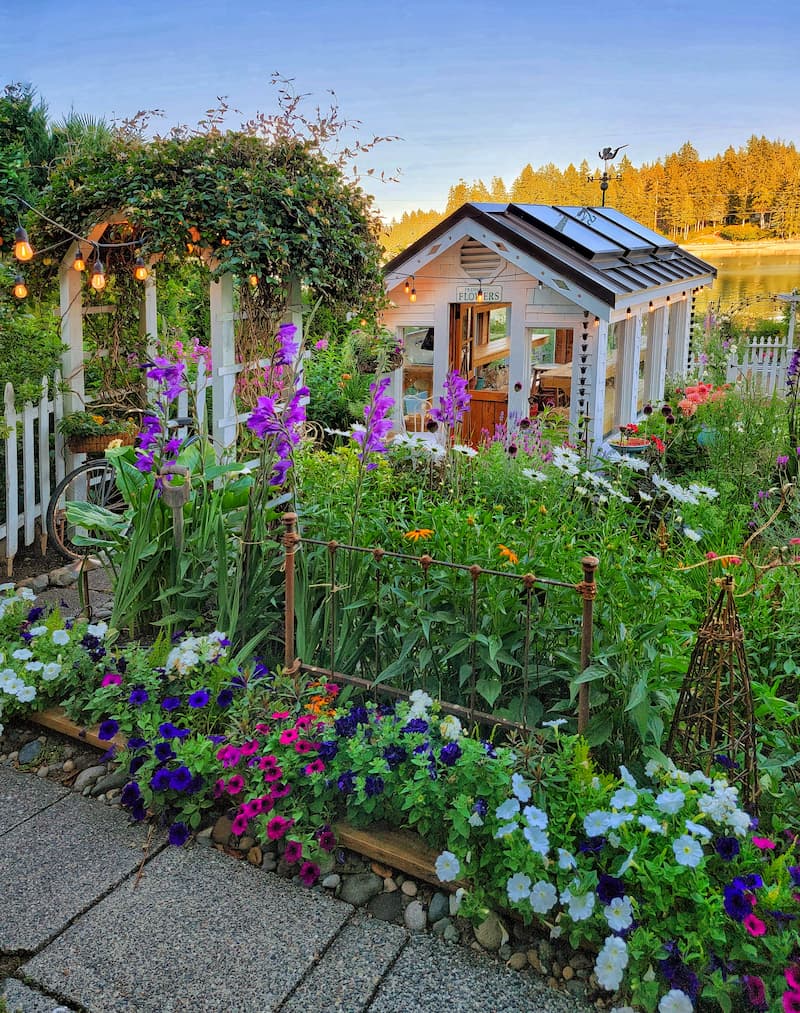
Mulch to Retain Moisture
Adding mulch to your garden beds is invaluable to any water-efficient garden.
Applying a layer of mulch around your plants helps retain soil moisture, reduce evaporation, and suppress weeds that compete for water. Organic mulches like straw, wood chips, or compost can also improve soil structure and fertility as they break down.
This simple practice enhances water conservation and promotes a healthier garden ecosystem.
Prevent Runoff
Runoff occurs when water, whether from rain or irrigation, flows over the soil’s surface rather than soaking in. This can lead to water wastage and potential soil erosion.
Watering your garden slowly and deeply is important to minimize runoff and allow the soil time to absorb the moisture. Techniques like drip irrigation or soaker hoses can help deliver water directly to the root zone, reducing surface flow.
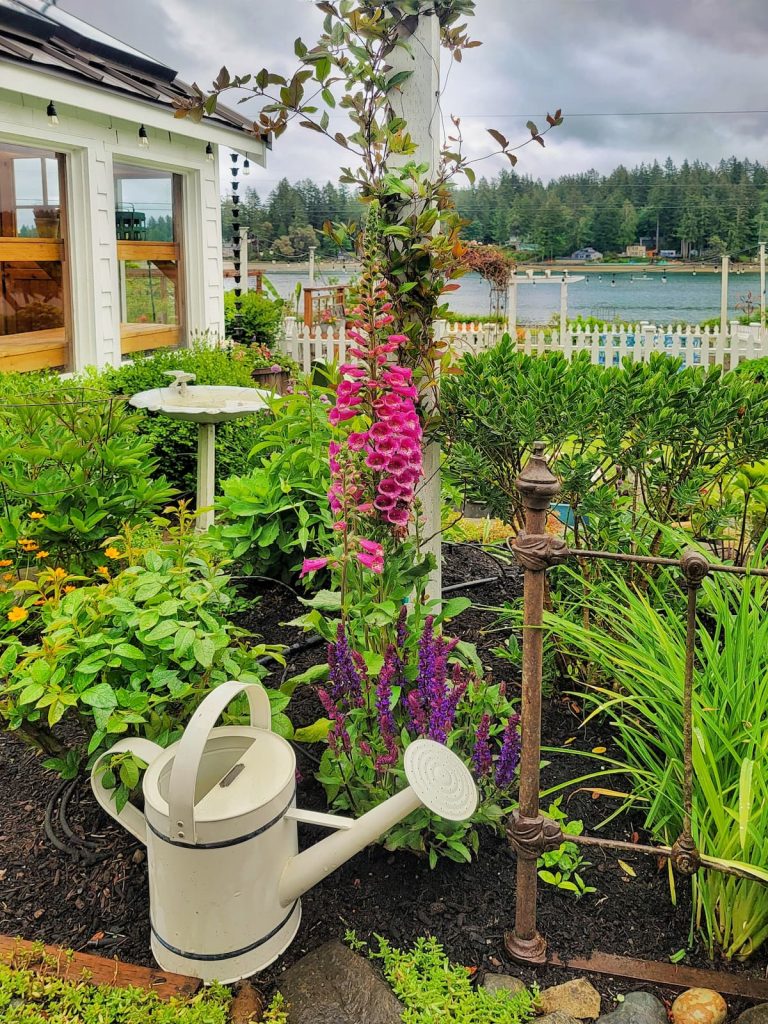
How Can You Tell How Much You’ve Watered Your Garden?
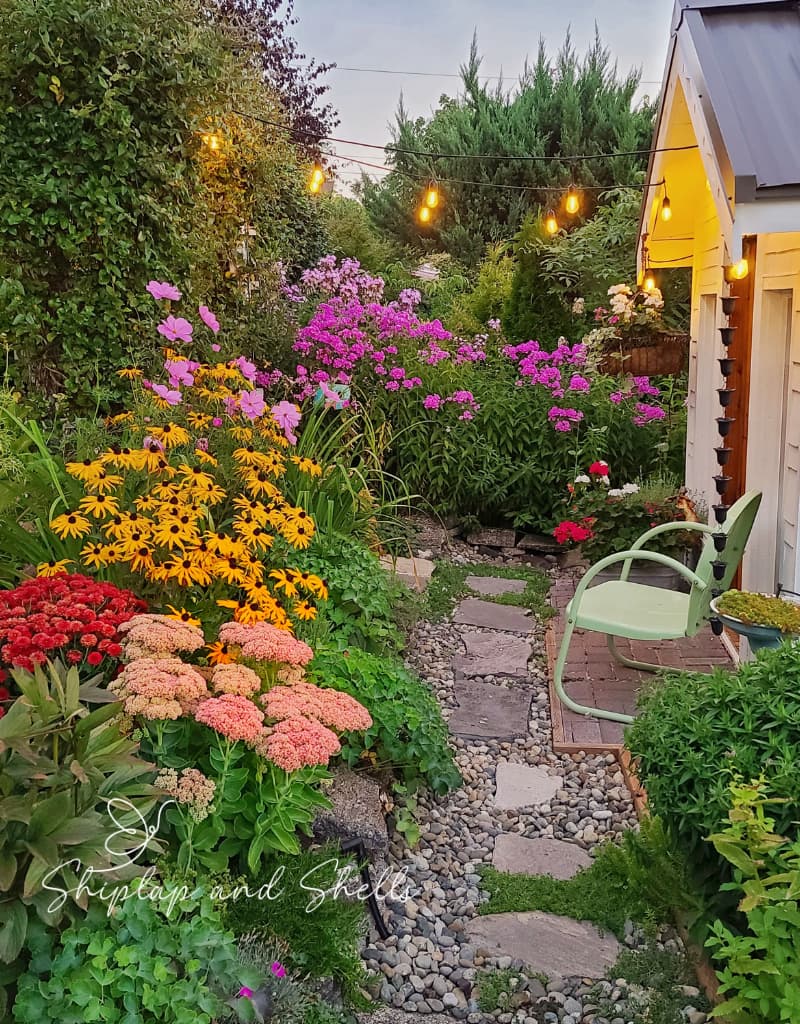
When is the Best Time of Day to Water Your Garden?
The best time to water your garden is early morning, typically between 6 a.m. and 10 a.m. Watering during these cooler hours allows the water to soak deeply into the soil before the heat of the day causes it to evaporate.
Morning watering ensures your plants have sufficient moisture to withstand the hottest part of the day, promoting better growth and health. Also, watering in the morning gives the foliage time to dry out before nightfall, reducing the risk of fungal diseases that thrive in moist, dark conditions.
If morning watering isn’t possible, the next best time is late afternoon or early evening, around 4 p.m. to 6 p.m. This timing still allows some drying of the foliage before night, though it’s less ideal than morning watering due to higher evaporation rates earlier in the afternoon.
Try to avoid watering your garden in the middle of the day.

How Many Minutes Should You Water a Garden?
The amount of time you should water your garden depends on several factors, including the type of plants, soil composition, weather conditions, and watering method.
However, a general guideline aims to deliver about 1 to 2 inches of weekly water, including rainfall. Here are some tips to help determine the appropriate watering duration for different methods:
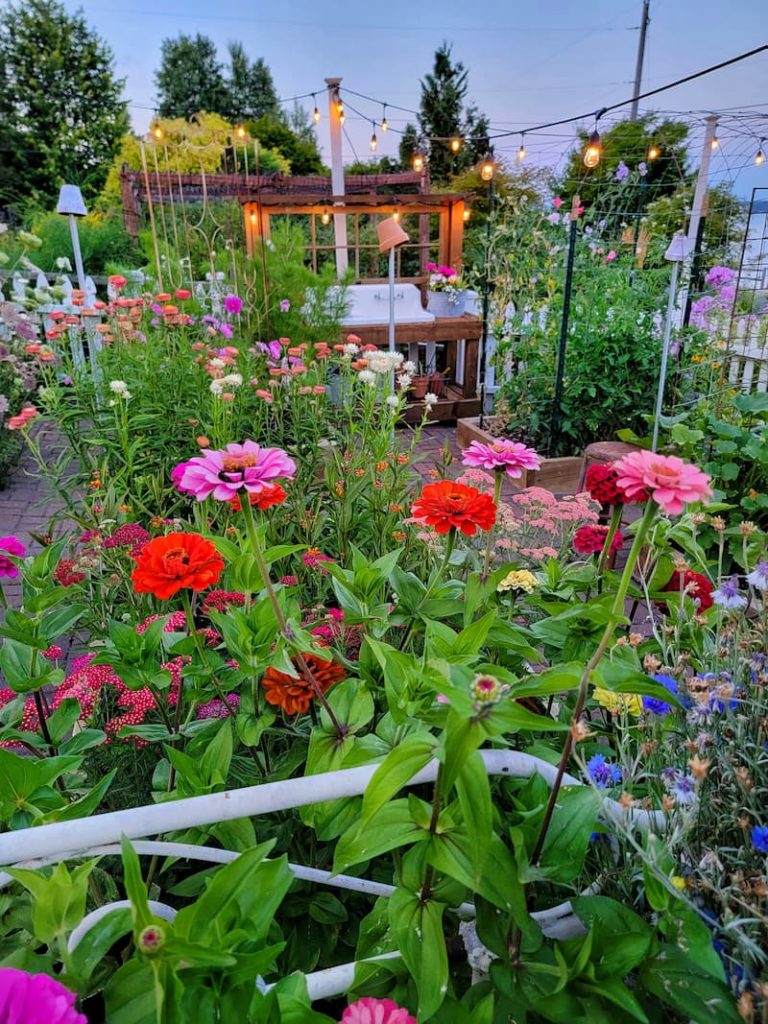
Should I Water My Garden Every Day?
Watering your garden every day is generally not recommended for most plants. Frequent, shallow waterings can lead to a shallow root system, making plants more susceptible to drought and less resilient overall. Instead, water deeply and less frequently to encourage deeper root growth and healthier plants.
Most gardens benefit from deep watering about two to three times a week, depending on plant type, soil composition, and weather conditions. Here are some key points to consider:

Efficient watering is a cornerstone of successful gardening. It helps conserve water while promoting healthy, resilient plants. You can ensure every drop counts by understanding your garden’s specific needs, choosing the right watering methods, and investing in water-saving equipment.
Remember to check the weather forecast, monitor soil moisture levels, and adjust your watering schedule to provide deep, thorough hydration rather than frequent, shallow watering. With these tips and tools, you’ll create a more sustainable garden and enjoy beautiful and thriving plants.
If you have any questions or additional suggestions, please share them in the comments below. And be sure to share this blog post link with anyone who may find these gardening tips useful.
Until next time,
Happy Gardening!

I’m a self-taught hobby gardener. Everything I share on my blog is my opinion and what has worked for me.
YOU MAY ALSO
Enjoy These Posts
Follow Me for More Inspiration
Shop my Amazon Storefront, LTK sources, and my favorite home decor, garden, and lifestyle products. When you purchase from one of my links, I earn a small commission, which helps me continue sharing all the content you expect on my blog.
Be sure to follow me on Pinterest, Instagram, Facebook, TikTok and LIKEtoKNOW.it. Do you like gardening? Join my Facebook Gardening Tips & Tricks group.

